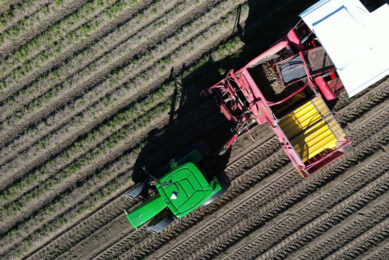‘Precision investments to help smaller farms make savings’

With the growing availability of modestly priced yet highly accurate precision farming technology, including auto-steering/guidance systems, tractor/implement headland management and automated headland turning, small and mid-sized farms across Europe could see relative returns on investment in precision farming equipment as significant as those made by larger farm businesses, says CNH Industrial.
With costs of inputs such as fuel, fertiliser and crop protection products continuing to rise, and wastage having cost and environmental impacts, both cropping and grassland farms – regardless of their size – can quickly recoup the cost of specifying or adding precision technology when ordering or upgrading a tractor, says Alessio Quatraro, connected services product manager with Case IH parent CNH Industrial.
Significant savings in fuel and inputs
“Reduction in overlapping from the use of guided steering offers potentially significant savings in fuel and inputs such as seeds and fertiliser,” points out Mr Quatraro.
“But there are further benefits to be gained. For example, automated steering systems controlled by GPS improve accuracy and safety at night or in poor visibility. For grassland work such as fertiliser spreading where previous passes are hard to detect and measure against, they also make pass-to-pass accuracy of application simple.”
RTK correction signal
“The more accurate the GPS signal used, the greater are the potential benefits to be gained. While a basic GPS signal with 10-15cm repeatability will allow auto-steering systems to make parallel passes sufficiently accurate for tasks such as manure spreading, an RTK correction signal and the 2.5cm repeatability it provides offers the possibility of adopting controlled traffic, with the same tractor field paths used year-on-year, minimising soil compaction and maximising crop growth potential,” Quatraro said.
According to him, RTK-guided auto-steering is particularly useful for the establishment and management of rowcrops such as maize/corn and roots, where precision seed placement and bout-matching are important for even growth and ease of harvesting, and are critical to inter-row weeding accuracy.
Text continues underneath image
Strip till
Quatraro said RTK use also aids repeatability in crop establishment methods such as strip till, protecting structure and reducing fuel use. “Not only does the pass-to-pass accuracy of GPS guided auto-steering reduce fuel consumption and improve work rates, but the reduction in tiredness and increase in focus means not only more productive but also safer operation, particularly important for those working alone.”
According to him, while adoption in recent years of precision farming technology has been widespread in large-scale arable farming, there is still huge scope for smaller and grassland-based farms to benefit from faster completion of tasks, greater efficiency and reduced operating and input costs, plus greater safety.
Mid-sized tractor
Alessio Quatraro cites the example of an owner-operator of a mid-sized tractor such as a Case IH Maxxum or Puma, common to mid-sized arable, mixed or livestock farms across Europe. Typically less likely to have been ordered with auto-steering, these tractors – and the implements they work with – could be significantly more productive for their owners if specified with such systems, he suggests.
“By specifying ‘AccuGuide-ready’ when ordering such a tractor it will come with the necessary electrical and hydraulic components. It’s then possible to either specify the AccuGuide components, minimising installation time – the AFS terminal, navigation controller and AFS 372 receiver – to be delivered installed on the tractor, or to add them at a later date.”
Alternatively, the AccuGuide-complete option means a new Case IH tractor comes fully equipped with AccuGuide from the factory, allowing the user to take full advantage of auto-guidance from the day of delivery, using the armrest-mounted AFS 700 terminal.
Text continues underneath image
Easier operation at headlands
Recent Case IH developments have combined the functions of the independent HMC II headland management and AccuTurn automatic headland turn systems to create AccuTurn Pro headland turn management, fully automating operations at bout ends and enhancing comfort and efficiency.
“With HMC II, once the driver has performed the simple process of programming a sequence of headland operations via time or distance – such as disengaging 4wd, raising the implement and switching off the PTO – a simple button press at the headland means all the programmed operations then occur automatically in sequence, with the reverse also possible when re-entering work. And it’s now possible to upgrade to AccuTurn Pro, which combines this with automated headland turning.”
Benefits of repeatability
Case IH AccuGuide-equipped tractors can receive a range of guidance correction, from the free EGNOS signal with its 20-25cm pass-to-pass repeatability, through Range Point RTX (15cm accuracy) to RTK + (2.5cm).
The repeatability provided by enhanced levels of accuracy also means that, for example, the same wheel tracks can be used when spreading fertiliser or liquid manure onto grassland, minimising trafficking of the land. Other possibilities include use of the same A-B lines when inter-row weeding a row crop that were originally set when it was established.
“Ultimately, there is a range of guidance technology that can bring benefits for small to medium-sized farms, particularly those with tractors run by owner-operators,” believes Mr Quatraro.
Join 17,000+ subscribers
Subscribe to our newsletter to stay updated about all the need-to-know content in the agricultural sector, two times a week.



